April 11.
There was no further building after noon on April 11. When I went out to take a look, the proud male was sitting on a branch above the nest.
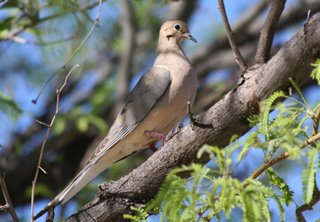 I tried to take a photo of the unoccupied nest without frightening him. The nest is about 20 feet above the ground in the crook of two rather thin leafy branches, so it's difficult to get a good photo of it.
I tried to take a photo of the unoccupied nest without frightening him. The nest is about 20 feet above the ground in the crook of two rather thin leafy branches, so it's difficult to get a good photo of it.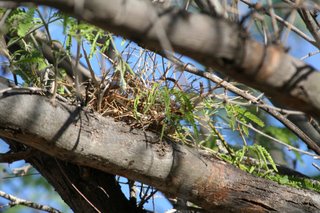 As far as I know, the nest was unoccupied that night.
As far as I know, the nest was unoccupied that night.April 12.
There was no bird on the nest the next morning. However, when I looked out in the afternoon, a dove was sitting on the nest.
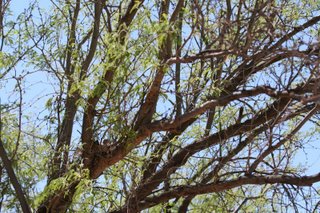 I use binoculars to watch the nest from my studio. I haven't seen the nest unoccupied. I'm assuming that there are eggs being incubated, but I haven't been able to see them, despite the open structure of the nest.
I use binoculars to watch the nest from my studio. I haven't seen the nest unoccupied. I'm assuming that there are eggs being incubated, but I haven't been able to see them, despite the open structure of the nest.- The Mourning Dove almost invariably lays two eggs. Clutches of three or four are the result of more than one female laying in the nest. A dove may have up to five or six clutches in a single year.
- A Mourning Dove pair rarely leaves its eggs unattended. The male usually incubates from midmorning until late afternoon, and the female sits the rest of the day and night.
Cornell Lab of Ornithology, All About Birds
April 17.
I haven't yet witnessed the changing of the guard. These photos were taken late yesterday afternoon, so, based on the Cornell authority, I assume this is the female.
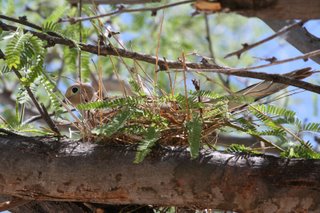
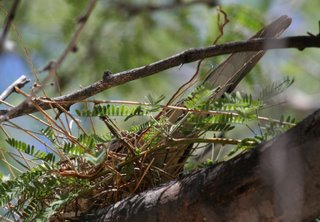 The ADW web site says that incubation usually lasts 14 to 15 days. Assuming that the female laid her eggs shortly after the nest was built, there should be babies before the end of April!
The ADW web site says that incubation usually lasts 14 to 15 days. Assuming that the female laid her eggs shortly after the nest was built, there should be babies before the end of April!
17 comments:
Hi Pam - I wouldn't be able to get any work done with such a tantalising sight right at my doorstep - you are so lucky to have such a wondrous backyard!
chiefbiscuit - Right now things are quiet; I just check to see that everything's all right at the nest. When the little ones arrive, I probably won't be concentrating on data analysis ;)
The dove babies will arrive right around the time of the baby eagles. This has to be the best time of the year! No wonder the pagans celebrated with eggs everywhere!
All this new life. I am amazed at the time these birds invest in bringing new lives into the world. Their dedication is a sight to behold. You are very lucky to have such an intimate vantage point.
Wow... everytime I check, you have wonderful pics. This season is definitely good for you.
I hope that you can get baby dove photos! How lucky you are to have them nesting in your yard. :-)
Plusieurs couples de ces tourterelles font leur nid à coté de notre maison. L'hiver , nous donnons de la nourriture aux oiseaux , ils sont très nombreux dans notre jardin , en particulier les merles et les mésanges .
Reproduction in our gardens is always a great sign that the environment we've created has been deemed "acceptable" by our natural neighbours - well done!
Pam - You take the most beautiful photographs. I am happy that the Mourning Doves completed building their nest. Now all they have to do is settle in and produce some little ones.
Isn't it odd that all my life I have thought these birds were called "Morning Doves" ..Thanks for straightening me out.
Do they realy make a mourning sort of sound??
this is such a lovely post. What fun to have a nest where you can watch. I will be watching for photos of the hatchlings.
rd - Looks like you'll be having your own bird families to watch soon! The doves continue to sit patiently - sheltering, protecting, as do the eagles, the falcons, the bluebirds we can see on the webcams. It's so easy to anthropomorphise and wonder what they're thinking about.
cynthia - I'm delighting in these new lives and so surprised that these birds are willing to live and breed on our suburban streets.
t.beth - I'll try. I hope they'll be visible from my vantage point.
jean - How wonderful to have several doves nesting by your house. I feel fortunate to have just one. Blackbirds I'm familiar with, but not titmice (les mésanges), which are found in the southeast U.S. I know they are very sweet little birds. We, too, feed birds, particularly when during droughts when the natural food is scarce.
tai haku - In our case, it's the environment we've left alone, although perhaps that's part of creativity, too. Now I have a new, blank, sterile walled patio which I'll gradually fill with native plants to attract birds, butterflies and other insects. Already today I had to stop planting to make room for a ruby-throated hummingbird who buzzed at me until I moved aside and let him feed on one of the newly planted salvias.
chancy - Thank you so much! you can listen to the sound of the Mourning Doves on the Cornell Ornithology site.
endment - I have a small pair of binoculars on my computer desk. Sometimes I see a large tail, sometimes an eye. I always wonder whether the dove can see me. I know it's well aware of me when I walk outside, although it's always perfectly still.
I'm in Rochester, NY and have, this morning, been watching a pair of mourning doves make their nest in the tree right outside my kitchen window. It is at eye level, about 2 1/2 feet from the window. It's been wonderful. The male goes off for one piece of grass or twig at a time. Comes back and stands on his mate's back. He leaves and she places the twig in the growing next. It's wonderful. It's made me feel wonder and wonderful!
Happy Birthday, Pam! I hope the next 70 years are even better!
Happy birthday Pam!
HAPPY BIRTHDAY PAM!!!
And many more...
Fred Gray
To those of you who came in through grrlscientist's blog - welcome! My blogging friends - old and new - have made this day so very special. I'll try to respond to you all individually over the weekend.
Does anyone know what happens to the other dove and the eggs if a mate dies? I had a pair of doves that built a nest in a tree outside my front door and I had to stop a cat from attacking one of the doves early this morning and I have not seen the dove since.
Leondra - I don't know. You might check with Louise at j.j. cardinal's, or Sharon at birdchick blog or Julie at Julie Zickefoose. They're pretty knowledgeable.
The female of this nest disappeared one morning. The eggs were alone for a while; then I saw a cactus wren up there. Later the eggs disappeared. About two weeks after that, a pair of white-winged doves started building on top of the old mourning dove nest. One afternoon I saw one of the pair hunting all through the tree. There was no bird on the nest and the eggs of the white-wings had fallen to the ground and broken. A third pair are now nesting in the same tree, but in a different spot. I hope they make it. Unfortunately, I'll be away when the eggs are due to hatch.
Post a Comment